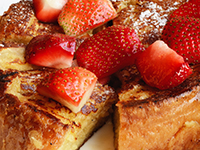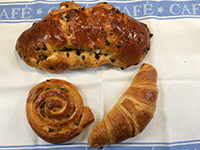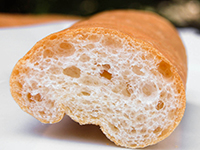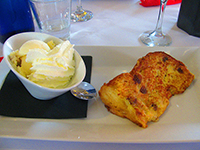 |
Pain perdu |
Pain perdu, a.k.a. French Toast in America, is the ultimate breakfast comfort food. It consists of slices of sweet bread high in high egg and butter, such as the brioche, dipped in milk and eggs, fried in butter, and served topped with powdered sugar. Definitely not a low-calorie diet ...
 Brioche. |
The brioche is generally thought of as being from France, but its origins are in fact Austrian. Its introduction to Parisian cuisine is the work of one August Zang, a 19th century Austrian entrepreneur known as a press magnate (founder the Viennese daily "Die Presse"), banker and mine owner. But before he did all this, he started the Viennese Bakery (Boulangerie Viennoise) in 1838 or 1839 on 92, rue de Richelieu. He started introducing Parisians to Viena-style baked goods made in a steam oven. The term pâtisseries viennoises first appeared in 1877 in a book by Alphonse Daudet. And so the baking tradition of the Viennoiserie was born.
 viennoiserie pastries (brioche, pain aux raisins, croissant). |
Pain Perdu
Ingredients:
- Lightly stale bread i.e. brioche
- 2 eggs
- 2 cups powdered sugar
- 1 sachet of vanilla sugar
- 2 glasses of milk
- Sweet butter
Preparation:
- Cut 6 slices of bread about 1.5 cm thick.
- In a bowl, beat the eggs with the milk, powdered sugar, and vanilla sugar.
- Stack the slices to keep them wet by stacking them on each side until they have absorbed all the liquid.
- Heat the butter in a frying pan and brown the bread slices on both sides.
- Serve warm, topped with strawberries and sprinkled with sugar.
 New Orleans style French Toast at Brennan's |
 New Orleans French bread (from Seriouseats.com) |
In the New Orleans style French toast, nutmeg is added into the egg mixture, the bread is fried in butter and oil, and sprinkled with cinnamon and powdered sugar. Louisiana cane syrup, honey, maple syrup or fruit syrup is used as a topping.
 Pain perdu in Paris, served as afternoon dessert |
back to Radim and Lisa's Well-Travelled Cookbook | email us
Last updated: March 3, 2017